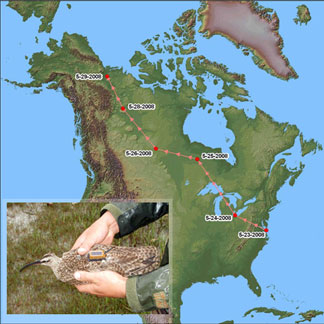You go girl: Winnie the whimbrel flies 3,200 miles in 146 hours
 Researchers from the College of William and 玛丽’s Center for Conservation Biology and The Nature Conservancy have observed the record-setting migration of a shorebird from feeding grounds on the Delmarva Peninsula to breeding grounds on the McKenzie River near the Alaska-Canada border.
Researchers from the College of William and 玛丽’s Center for Conservation Biology and The Nature Conservancy have observed the record-setting migration of a shorebird from feeding grounds on the Delmarva Peninsula to breeding grounds on the McKenzie River near the Alaska-Canada border.
The bird’s six-day flight is challenging conventional scientific thinking about long-distance migration routes and underscores the ecological importance of areas of the Delmarva Peninsula, which includes the state of Delaware and the Eastern Shore of 玛丽land and Virginia.
The bird, a female whimbrel known as Winnie, was fitted with a state-of-the-art satellite tracking device weighing just over a third of an ounce, according to Bryan Watts, director of the Center for Conservation Biology. Winnie left the study area on May 23, flying northwest at an average flight speed of nearly 22 miles per hour, covering more than 5,000 kilometers (3,200 miles) in no more than 146 hours.
“This discovery sets a new distance record in the flight range of this species and highlights the hemispheric importance of the Delmarva Peninsula as a staging area for migratory shorebirds,” Watts said. “The flight documented this spring challenges some long-held assumptions and raises several new questions about whimbrel ecology.”
佤邦
The seaside of the Delmarva Peninsula has been recognized as a globally important bird area, a hemispheric shorebird reserve and a UNESCO biosphere reserve. Watts said Winnie’s flight shows at least some of the birds are migrating much longer distances than scientists had thought, a revelation that highlights the area’s value as a feeding station between the birds’ tropical wintering grounds and their Canadian breeding areas.
“The discovery that whimbrels use the site as a terminal staging area before embarking on a transcontinental flight suggests that the site is uniquely suited to provide the tremendous amount of energy required to prepare birds for such a flight,” he said.
In addition to setting a distance record, the bird bearing the tracking device also set a record for size, weighing 640 grams (1.4 pounds), which Watts said is 40 percent more than any other whimbrel recorded.
















